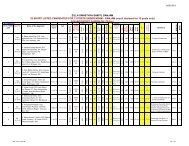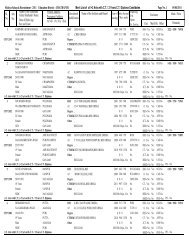Similar
Similar
Similar
You also want an ePaper? Increase the reach of your titles
YUMPU automatically turns print PDFs into web optimized ePapers that Google loves.
1.1 INTRODUCTION<br />
The Ganjam District is named after the old township and European Fort of Ganjam<br />
situated on the Northern bank of river Rushikulya which was the Headquarter of the District.<br />
The rock Edicts of Ashok, inscribed on a hill then known as Kapingala Parbat are found at<br />
Jaugada, The Ganjam area was a part of ancient Kalinga, which was occupied by Ashoka in<br />
261 B.C. Though in 1757 it was French Commander Bussy, who marched into Ganjam and<br />
realised areas of tribute from feudal chiefs, it as English who ultimately defeated the French in<br />
the Decan and annexed Ganjam in 1759. The Office the Collector Ganjam was established in<br />
1794. Originally, the district was in Madras Presidency in the British period. It had only 3<br />
Government –Taluks, 16 large proprietory estates, 35 minor Zamindar. In Madras Presidency,<br />
the area of the district was 8311 Square miles of which 5205 square miles comprised of agency<br />
tracts. The Headquarter of the district at Ganjam was abandoned in 1855 owing to out-break of<br />
a dreadful epidemic fever by which 80% population of Ganjam town was reduced .The<br />
Headquarter temporarily shifted to Gopalpur then to Berhampur and finally in and around 1902<br />
to Chatrapur. The district got separated from Madrass Presidency and formed a part of the<br />
newly created State of Orissa province with effect from 1.4.1936<br />
1.2 LOCATION<br />
The District of Ganjam in its southern periphery borders to the State of Andhra Pradesh<br />
(Srikakulam District). The Bay of Bengal in the Southeast covers approximately 60 kms of<br />
coastal length. The Geographical area of Ganjam District is about 8206 Sq.kms. The<br />
District lies between 19 o 4’N to 20 o 17’N latitude and 84 o 7’E longitude to 85 o 12’E.<br />
Ganjam district is broadly divided into two divisions, the coastal plains area in the east and<br />
hill and table lands in the west. The eastern ghats run along the western side of the district.<br />
The plains are narrow because of the absence of big rivers. The coastal plains in the east<br />
contain more fertile and irrigated lands. Towards the centre and south it is hilly with<br />
beautiful well watered valley. The south eastern portion is fertile. The extreme north east is<br />
occupied by a portion of the famous Chilika lake.<br />
19
















